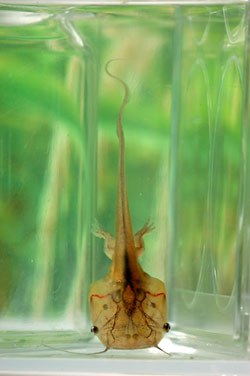Scientists report first genome sequence of frog
The African clawed frog, Xenopus, has helped scientists understand how embryos develop and the many chemical reactions going on inside dividing cells. Now, scientists report the first draft genome sequence of Xenopus, setting the stage for a more complete genetic analysis of this popular frog.
April 29, 2010
A team of scientists led by the Department of Energy’s Joint Genome Institute (JGI) and the University of California, Berkeley, is publishing this week the first genome sequence of an amphibian, the African clawed frog Xenopus tropicalis, filling in a major gap among the vertebrates sequenced to date.
“A lot of furry animals have been sequenced, but far fewer other vertebrates,” said co-author Richard Harland, UC Berkeley professor of molecular and cell biology. “Having a complete catalog of the genes in Xenopus, along with those of humans, rats, mice and chickens, will help us reassemble the full complement of ancestral vertebrate genes.”
The high-quality draft sequence of the genome of X. tropicalis, often called the Western clawed frog, will also aid researchers who now use the frog’s more popular cousin, Xenopus laevis (zen’-uh-pus lay’-uh-vus), to study embryo development and cell biology. X. laevis, with its large and easily manipulated eggs, has told scientists a lot about how a fertilized egg develops into an embryo, including how embryos set up front-back and head-tail axes. The genome of tropicalis will help scientists connect genetic changes with developmental milestones in both species, Harland said.
“Xenopus has been among the last model organisms to be sequenced,” after the mouse, chicken, nematode, zebrafish and fruit fly, he said. “It will be tremendous to have a high quality sequence of X. tropicalis upon which to build the X. laevis sequence.”
“The availability of the Xenopus genome also opens up the possibility of studying the effect of endocrine disruptors at the molecular and genomic level,” added first author Uffe Hellsten, a bioinformaticist at the JGI. These chemicals mimic frogs’ own hormones, and their presence in lakes and streams may be partly responsible for the decline of frog populations worldwide.

A late-stage Xenopus tropicalis tadpole, with emerging hindlimbs. Through the skin of the head, the optic, trigeminal and olfactory nerves, the paired thymus and large blood vessels are visible. (Siwei Zhang, Jingjing Li, Enrique Amaya/Univ. of Manchester (UK), Courtesy of Science)
“Hopefully,” he added, “understanding the effects of these hormone disruptors will help us preserve frog diversity and, since these chemicals also affect humans, could have a positive effect on human health.”
Hellsten, Harland and 46 other scientists from 24 institutions will publish the draft genome sequence and genome-wide analysis in the April 30 issue of the journal Science.
Xenopus, meaning “strange foot,” is a genus of more than 20 frog species native to sub-Saharan Africa. When biologists discovered in the early 20th century that these frogs were unusually sensitive to human chorionic gonadotropin (HCG), they were adopted widely as a low-cost pregnancy test in hospitals, primarily in the 1940s and ’50s. Inject a frog with a woman’s urine and, if she is pregnant, the HCG in the urine will make the frog ovulate and produce eggs in 8-10 hours.
Imported from South Africa, these frogs were kept in hospitals around the world, where scientists soon discovered their value in studying embryo development. Their large eggs also were easy to inject with chemicals, making them big spherical test tubes, Harland said. Plus, the frogs could be induced to lay eggs at any time of year by injecting them with hormones.
When the Joint Genome Institute decided to sequence a frog genome, however, the Xenopus research community recommended X. tropicalis over X. laevis because tropicalis has half the genome size. While X. tropicalis is diploid, with two copies of each gene on 10 pairs of chromosomes, the X. laevis genome has undergone duplication and could have four copies of every gene on 18 pairs of chromosomes. Sequencing X. laevis would have been not only more costly, but also harder, because of the difficulty of matching genes to the proper chromosome.
Nevertheless, the high quality draft sequence will provide a “scaffold upon which to assemble the X. laevis genome,” Harland said. Harland and Daniel Rokhsar, co-lead of the Xenopus genome project, UC Berkeley biology professor and JGI scientist, have applied for a National Institutes of Health grant to sequence the X. laevis genome. Harland said that, because of faster and cheaper sequencing machines, the cost would be about $1 million – about 20 times less than the cost of sequencing the X. tropicalis genome over a three-year period starting in 2002.
Though the draft genome sequence has been available to scientists for several years, the new paper is the first analysis of the full genome. According to Hellsten, a comparison of regions around specific genes in the frog, chicken and human genomes shows that they are amazingly similar, indicating a high level of conservation of organization, or structure, on the chromosomes.
“When you look at segments of the Xenopus genome, you literally are looking at structures that are 360 million years old and were part of the genome of the last common ancestor of all birds, frogs, dinosaurs and mammals that ever roamed the earth,” said Hellsten. “Chromosome archaeology helps to understand the history of evolution, showing us how the genetic material has rearranged itself to create the present day mammalian genome and present day amphibian genome.”
“The rat and mouse genomes gave us the impression that genomes evolve quickly, but that turns out to be characteristic of rodents, not of all organisms,” Harland said. “Instead, it seems that breaking and rearranging chromosomes are extremely rare events in evolution.”

The smaller eggs of Xenopus tropicalis next to the larger eggs of Xenopus laevis. The eggs of both these species of African clawed frog have long been used as experimental systems in which to study vertebrate cell and developmental biology. (Richard Harland/UC Berkeley)
The frog genome also contains genes similar to at least 1,700 genes that, in humans, are associated with disease. Thus, understanding these genes in frogs could help biologists understand how they are involved in human disease, Hellsten said.
The X. tropicalis genome, which contains more than 20,000 genes – humans have about 23,000 – is of particular interest to Harland, who is part of a small community of scientists studying this frog in addition to its larger cousin, X. laevis. The frogs take up less room and have a shorter lifecycle – as little as 4 months instead of a year or more – while their smaller eggs are still relatively easy to manipulate and inject. The sequence will speed up the adoption of X. tropicalis for genetic studies in addition to developmental and cell biological studies, he said.
Harland injects eggs with nucleic acids that activate or block the action of specific genes or their protein products in order to discover their function.
“If you want to knock down multiple gene products, it’s a much simpler exercise to knock them down in tropicalis, with only two copies of each gene, as opposed to knocking down or targeting gene products in laevis, where the problem is twice as complex,” he said. “Now that we have a complete catalog of genes, we can also design a gene chip to look at the changes in gene expression across the whole genome, whereas previously we were restricted to the examples people had chosen to study.”
This sequencing was supported by the Department of Energy, the National Institutes of Health and the National Library of Medicine.